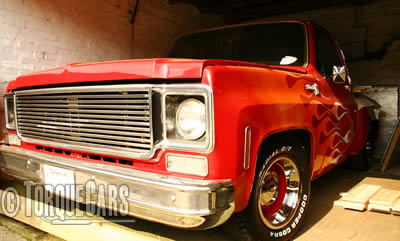Storing a Car
"Storing up trouble for yourself"

The condition of a car can rapidly deteriorate when it is stored. By taking a few simple safeguards you can keep the car in good condition.
Rust is your biggest enemy so you need to avoid damp - heated garage or put car inside a sealed cover.
TorqueCars recommend that when you put a car into storage you first of all wash it thoroughly and ensure that all brake dust is removed from the wheels.
Then you need to ensure the car is completely dry - a hot day is best. When the car is dry you need to apply a protective layer of wax which will help to keep out corrosion.
When a car is standing you still have to worry about corrosion inside the engine. We recommend that you spray some oil into each of the cylinders. The easiest way to do this is by removing the spark plugs.
To ensure the oil coats the cylinder walls you will need to crank the engine for a single revolution (short burst) with the plugs removed to prevent combustion. Doing this will protect the internal areas of the engine from corrosion. (Any fuel sprayed in will quickly evaporate away.)
Lay a plastic sheet on the ground to help keep the damp from rising up into the car itself. If you can get a dehumidifier installed that would be good as this will also help to keep the damp air away from the car.
Don't let mice/rats nest in your exhaust - stuff some rags in the end. (Put a notice in the car reminding you to remove the rags). The same applies to the air intake in the engine. Small rodents love to find little tubes and pipes to nest in so don't take chances.
After a while the brakes will bind on that is stick to the disks, so avoid leaving the handbrake engaged. Instead of the handbrake leave the car in gear and chock the wheels.
If you are leaving the car for a long time it would usually be best to raise it up and leave it on axle stands. (Please note that axle stands are not always sturdy and you should always use caution around a car on axle stands.) This will reduce pressure and wear on the tyres and suspension.
Ensure that you fully inflate the tyres and keep them topped up. Soft tyres will quickly start to deteriorate and they will always lose pressure over time so you will need to keep them topped up.
Wiper blades can stick to the glass over time so put some rags underneath them to prevent this. Lubricate all hinges with white grease and this will help protect them from seizing up.
Keep the battery charged and topped up. It is best to remove the battery from the car when you are storing it. Car alarms, electrical circuits and even the clock will eventually drain the battery and batteries last longer with a charge in them so avoid letting the battery go flat.
Check antifreeze strength before winter. Even if the car is in a cosy garage you still risk freezing when the cold weather comes. DO NOT DRAIN THE CAR COOLANT. The moisture inside will mix with the air and rust will start to appear in the waterways.
Regular maintenance regimen of a stored car.
Rotate all of the wheels, especially if it is not on axle stands. This keeps the bearings from sticking as well as changing the pressure point on the tyre.
Some recommend starting the car briefly if you are storing the car for longer periods of over 6 months to 12 months. Do not idle the engine and allow it to come up to temperature but rather hold the revs and allow the car to warm up quickly. Ideally the car should be driven for 15 miles every 60 days allowing the engine to get up to temperature. This is not always practical due to insurance and legal issues if the car has been registered out of use.
Just starting the engine for short periods can cause major problems and is a great way to accelerate the wear and tear due to corrosion especially in the exhaust. Always allow the car to fully get up to temperature before shutting the engine off. Whilst you have the engine running you should also briefly run the airconditioning compressor/heater fan for a short while on both hot and cold settings.
When you have finished running the engine you will need once more to redo the previous steps such as oil in the engine and reinsert the rodent protectors.
Also the windows should be periodically wound up and down to keep them free running. This is especially important on cars with electric windows as a seized window can burn out the motor.
Turn the steering fully from lock to lock to prevent the steering rack/power steering pump from seizing up. This can be done with the car on axle stands.
Hopefully your car survives its storage in perfect condition, sadly there are no guarantees here but at least you have taken every precaution. When you go to put it back on the road make sure it has been thoroughly serviced. You should also ensure that the car is safe to drive. Rubber suspension bushes, brakes and steering should all be carefully checked before using the car on the roads.
If you liked this page please share it with your friends, drop a link to it in your favourite forum or use the bookmarking options to save it to your social media profile.
Check out TorqueCars new YouTube channel, and see their awesome new content...
Feedback
Please use our forums if you wish to ask a tuning question, and please note we do not sell parts or services, we are just an online magazine.
Help us improve, leave a suggestion or tip
